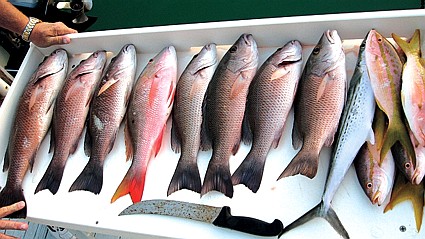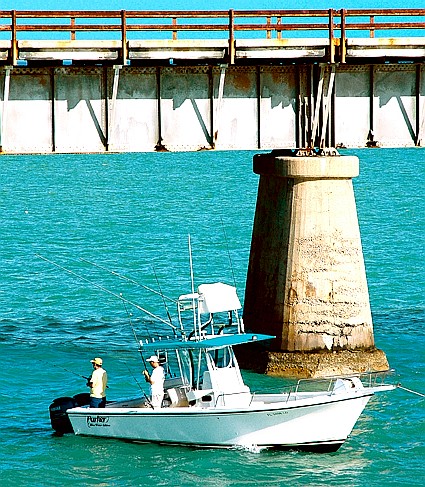March 27, 2012
By Florida Sportsman
Nearly all of the more than 40 bridges linking the Florida Keys harbor excellent mangrove snapper fishing beneath the spans. It's a fishery that's been booming for the last year. Anglers patient enough to dial in the drift with bait-tipped jigs are scoring big. And I mean big—as in offshore-grade snappers ranging up to 5 pounds. We're not talking about the little snaps that fit into the palm of your hand. These are mature, educated fish that demand specialized tactics and tackle.
Here's the scoop.
Some of those Keys bridges provide good access for shore fishing, while others are best approached from a boat. For the purposes of this article, I'm going to outline the techniques which I've found work best from a boat. Shore-based anglers, of course, may adopt many of these recommendations.
Anglers prone to mal de mer, or who own one of the smaller mosquito fleet boats, find the bridges an excellent alternative when winter winds whip up the seas over the reef. Bigger boats can also enjoy bridge fishing in deeper waters and wider, less-constrictive spaces—but note that you're best off fishing aboard a boat small enough to navigate through the spans, in the event of a tide change. Having to motor down to the main span, and drive around to where you want to fish, is something of a hassle; it may also create some conflict with other fishermen, if you accidentally throw a “hang ten” wake where they're anchored. In any boat, travel slow near bridges. Big wakes may dislodge anchors, and in a strong tide that means trouble.
 |
On the subject of anchors, where and how you position your boat has a huge bearing on bridge-fishing success. I've found that most fish relate to the front side and the back of the pilings as well as the sides; ideally, you want to anchor so you can easily work one side of a piling as well as one side of the next piling, or both sides of one piling. This takes a little practice to get the correct amount of anchor rope out and not get too close or too far away from the bridge. Once you're solidly anchored, use your motor (ignition off) as a rudder if the current is strong. Turning it hard in one direction or the other, you can move your boat into the best position.
You want to be able to cast where your bait will be unhindered by current as it drifts by those pilings. A perfect presentation is one where the current sweeps the bait along the same path that the fish expect their prey to be taking. They quickly find these lanes and set up shop in them. Experiment with jig size and shape when looking for the best line of drift. The most strikes will tell you where those locations are, and they will be the same lanes, at the same tide, most times. I prefer to anchor well uptide and then let the current and the wind determine where the boat finally rests. I then either pull in some anchor rope or let some out for final adjustments. Anchor as many times as you have to in order to get the position right. Most times you're in shallow water; weighing anchor isn't nearly the hassle it is offshore.
Drag-Free Drift is Key
I use a jig-and-bait combo almost exclusively when snapper fishing along bridges. I also use fairly light tackle, either 15-pound-test monofilament or braided polyethylene line. And no more than 25-pound-test leader, usually. This allows you to probe the bottom, middle and top of the water column by varying the speed of your retrieve or by slowing the drift through the tip of the rod. Also, fishing the current in this manner helps avoid the countless snags lurking below. Bridges are notorious places to find chunks of old concrete or steel bars and certainly we cannot forget the mono jungle of snagged lines that free-floats in the waters from the topside bridge anglers.
 |
Try to eliminate any factor that may cause your drift to look or feel unnatural to the fish. Many times I hold my line high in the air to reduce the amount of line that is in contact with the water. Too much line in the water accelerates the drift unnaturally. Sharp-eyed mangrove snapper in the 5-pound range have been watching lures and baits drift by for years; they know the drill.
Selecting the right-size jig is another delicate matter. Using one that's too heavy is just as bad as using one that's too light; the one snags bottom, while the other never gets to the fish below. Accept that you'll need to tie on varying jig weights as the current flows and then wanes. Use the heavier ones when the tide is ripping, then gradually step down to the lighter models as the current begins to subside. A selection from 3/8- to ¾-ounce is generally adequate.
 |
Be alert to the jig hitting bottom, and then raise the rodtip and repeat until that familiar tap signals a bite. Most jig hits will occur on the drop or the first part of the rise, so be especially vigilant then. I once watched from a bridge while an angler drifted a shrimp-imitation lure into several waiting snook below. Each time a fish swam over to the lure, sucked it in and promptly blew it out. Meanwhile, the shore angler below felt nothing. Set the hook on any variation of the norm when jig fishing. Mangrove snappers in particular are difficult to hook due in part to their rapid snapping when attacking a bait. Be sure to pull hard and low away from the bridge once a hookup occurs, as many times the bait has fallen prey to a grouper. Grouper have a bad habit of diving into any little hole or crevice they can find.
Just as you'll need to switch jigs as the current changes, likewise you'll need to zero in on where the fish are holding. Keep in mind that current flow varies through the tide cycle, from nonexistent at slack tide, slowly gaining velocity until a mid-tide peak, and then a wane as it approaches slack again. How fish relate to structure changes through these fluctuations.
When the current is steaming, snapper stick very close to structure, as it reduces the effort they need to maintain their position. Food is delivered right to them, for the most part. A hard-running current also creates areas of back pressure or eddies where fish can rest but be close enough to dash out into the current if a hapless morsel drifts by. Directly in front of or behind pilings may be pockets of calm water; these are also prime areas to drift a jig-laden bait through when the tide is ripping. As the tide slackens, fish pull away from the structure to forage in open water, and at dead tide, they may lollygag in any area near structure. When the current resumes, they migrate back to the structure and the process repeats itself—often on the opposite side of the structure. Both boat and shore-based bridge anglers need to be aware of this fact and adjust as the fish do.
Fine Points of Bridge Snapper Fishing
-- After setting the hook, pull low and hard away from the structure. This accomplishes several things. It quickly separates fish from snags and usually puts the fight in clear water (vital if a big grouper happens to gobble the bait). Also, there's less risk of spooking other fish. Letting a hooked fish struggle amid the school is a surefire way to “spook the herd,” if you will. Veteran snapper anglers know these fish can easily go into lockjaw.
-- Pay attention to the condition of your line and leader. Several fish on a leader or a long fight can easily chafe a section and the next fish just may be that picture-taker of the day. Do not let a small thing like a chafed leader prevent that Kodak moment.
-- File hook points after several catches or snags. With a bait attached to the jig, you need a razor-sharp hook to penetrate a snapper's mouth. Even chemically sharpened hooks can use a slight honing now and then.
-- Bridge safety: Be sure your boat is in good working order before anchoring uptide from a Keys bridge. That means a fully charged battery(s), and full confidence that when you turn the key, you'll power up. If your anchor pulls and you can't get the motor started, you're in trouble. Similarly, don't mess around in big channels like Bahia Honda in a 10-horse johnboat. The current really smokes beneath these deep bridges. Add choppy water to the equation, and you need a strong
motor and sufficient hull to get around safely.
Bridge Baits
The best baits are hardy, small live fish hooked through the lips. In Florida's subtropical waters, shrimp are too vulnerable to the “machine gunners”—undesirable fish which peck ‘em apart in quick succession.
Pilchards get the nod in the Keys, especially those in the 3- to 5-inch range. You can jig them up with sabiki rigs (sizes 4 through 8, generally) in channels or net them with a 3/8-inch-mesh castnet on grassflats (careful not to contact bottom with your prop). Small pinfish also work well, either hooked on bits of shrimp over a grassflat, corralled in a pinfish trap, or purchased at a tackle shop.
Chumming isn't necessary, and in fact it may bring in too many nuisance fish, which can turn off the bigger snappers.
With an adequate supply of pilchards, you end up chumming fish when you miss strikes, which you will.
FS

